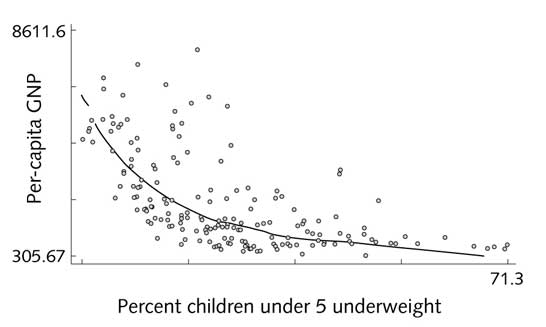
Figure 1-16. Relationship between per capita gross national product (GNP) and nutrition. Source: Haddad, 2000.
(Seale et al., 2003). Per capita meat consumption in highincome countries was more than 11 times higher than that in low-income countries in 2002 (WRI, 2006).
Poor rural infrastructure contributes to high food costs for rural poor people. For example, in the upper east region of Ghana, expenditure on food averages over 75% of the household budget. Farmers who lack storage facilities or access to credit are forced by necessity to sell their crops soon after harvest when prices are at their lowest. During the dry season, they buy food when prices are at their highest. In many cases it is women who spend the greatest effort in ensuring food security for the family, cultivating garden plots, carrying out income generating activities and spending the largest portion of their income on food, followed by health. In some cases, women's enterprises pay their women employees in food, in order to ensure that the household benefits directly from the woman's work and that cash earnings are not diverted to other purposes (IFAD, 1998).
Nutrition
Nutrition is one of the major components of health. A healthy diet is typically seen as one which provides sufficient calories to meet the individual's energy needs, as well as adequate protein, vitamins, minerals, essential fatty acids and trace elements to ensure growth and maintenance of life. While the volume of food intake is important, an adequate intake of calories does not in itself ensure that the need for micronutrients has been met. Good nutrition is based on principles of variety, proportion and balance in the choice of foods. Good nutrition has much to contribute to poverty reduction. It is intrinsic to the accumulation of human capital, since sound nutrition provides the basis for good physical and mental health, and is thus a foundation for intellectual and social development and a productive life.
Malnutrition is often linked to poverty and disease, for each one lays the groundwork for the others and contributes to its perpetuation. In developing countries where nutrient deficiencies are most prevalent, malnutrition in children is the result of a range of factors including insufficient food, poor food quality, and severe and repeated infectious disease. It is a contributing factor to childhood death from diarrhea, acute respiratory illness and to a lesser extent, malaria, all among the leading causes of under-five mortality. Even children with mild to moderate malnutrition are at an increased risk of dying (Rice et al., 2000; Caulfield
et al., 2004). Improving nutritional status, particularly of biologically vulnerable groups such as infants, children, and pregnant and lactating women, weakens the transmission of poverty from one generation to the next. AKST has a role to play in developing food crops of high nutritional value that can be produced at affordable prices.
More than 50 nutrients are needed to maintain good health, but the scope and global impact of inadequate nutrition have been studied for only a few critical nutrients, such as iron, iodine, vitamin A and protein. Of these, iron deficiency anemia is the most prevalent nutritional deficiency worldwide and is associated with parasitic infestation, chronic infection as well as other micronutrient deficiencies. It impairs physical and cognitive development in children and leads to reduced capacity for work and lower productivity in adults. In pregnant women, iron deficiency anemia contributes to maternal morbidity and mortality and increases the risk of fetal morbidity, mortality and low birth weight (UNSCN, 2004). Inadequate iodine in the diet affects nearly two billion people, approximately 23% of the global population, and is the primary cause of preventable mental retardation in children (UNSCN, 2004). Vitamin A deficiency, which affects an estimated 140 million preschool children and seven million pregnant women every year, can lead to night blindness, anemia, growth retardation and increased vulnerability to infectious disease and death (UNSCN, 2004).
Malnutrition can result from either excessive or inadequate intake of nutrients. Protein-energy malnutrition, for example, results from an imbalance between the intake of protein and carbohydrates and the body's actual need for them. Inadequate intake leads to malnutrition in the form of wasting, stunting and low weight; excessive intake leads to excess weight and obesity. Child malnutrition is particularly serious and more prevalent in rural than in urban areas.
A healthy diet is often pictured as a pyramid of food groups, with cereals and other staples at the base and progressively smaller layers of fruits and vegetables, followed by meat, poultry, fish, eggs and dairy products, and finally culminating in small amounts of fats and sugar at the peak. A balanced diet would draw on a variety of foods from each of the main groups, respecting the proportions assigned to each. Current patterns of food consumption involving overconsumption of fat, sugar and salt coupled with inadequate intake of whole grains, fruits and vegetables as well as the trend towards excess weight and obesity in many countries demonstrate how far from the ideal the modern diet has become. As the global burden of disease shifts to chronic illnesses, such as diabetes, cardiovascular disease, hypertension and cancer, there is a growing recognition of the impact of dietary habits, environmental hygiene and lifestyle choices on health outcomes (WHO, 2003a).
In recent years, efforts have been directed to analyzing the nutritional content of traditional, locally produced foods, taking into account food availability and eating patterns, in order to draw up dietary guidelines that are culturally meaningful and easily applicable in local conditions. Such food-based guidelines go beyond nutrients and food groups to a more holistic vision of nutrition based on how foods are produced, prepared, processed and developed. The health implications of agricultural practices, production and distribution of food products, sanitary standards and com-